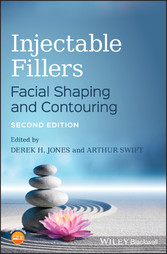Suchen und Finden
Service

Injectable Fillers - Facial Shaping and Contouring
Derek H. Jones, Arthur Swift
Verlag Wiley-Blackwell, 2019
ISBN 9781119046950 , 240 Seiten
2. Auflage
Format ePUB
Kopierschutz DRM
CHAPTER 1
Injection Anatomy: Avoiding the Disastrous Complication
Arthur Swift1, Claudio DeLorenzi2, and Krishnan M. Kapoor3,4
1 The Westmount Institute of Plastic Surgery, Montreal, QC, Canada
2 The DeLorenzi Clinic, Kitchener, Ontario, Canada
3 Fortis Hospital, Mohali, Punjab, India
4 Anticlock Clinic, Chandigarh, India
Over the past two decades, neuromodulators and ‘dermal’ fillers have provided cosmetic physicians with the tools necessary to enhance facial features non‐surgically and usually with minimal discomfort. Having a profound impact on beauty is no longer limited to a surgeon's knife wielded by an experienced specialist proficient in facial anatomy and aesthetics. Originally intended for the safer location of intradermal deposition, synthetic filler therapy has been extended beyond the eradication of unwanted wrinkles and folds into the realm of facial contouring and volume restoration. The transition of more robust fillers into deeper treatment planes by practitioners unfamiliar with the attendant vital anatomy has resulted in the appearance of devastating intravascular complications.
Complications have arisen from the use of various dermal fillers since their inception. Historically, paraffin, Vaseline, and many other materials were used that could not only cause many of the same types of devastating vascular complications, but also result in serious adverse events that were long lasting due to tissue incompatibility and immune‐mediated issues [1]. Fat may be considered the archetype of ‘deep’ fillers, and embolic phenomena have been reported from many sites over the decades since it was first developed as a technique for volume replacement (including blindness, stroke, and tissue necrosis) [2]. Since the development of the hypodermic needle, many different drugs that were either partially insoluble or that had serious inflammatory effects on the linings of blood vessels (particularly arterial wall linings), were implicated in many serious adverse events resulting from the ensuing ischemia when accidental intra‐arterial injection caused inflammatory desquamation of the arterial lining tissue. From this historical perspective, then, the present state of filler complications does not present anything new, but rather mirrors experiences with other filler materials. The most successful modern fillers (the class of hyaluronic acid derivatives) now mainly show improved results for tissue integration and also lack inflammatory effects [3].
It is imperative that all injection specialists have an intimate understanding of facial anatomy and its relationship with injection therapy so that serious adverse events are minimized. A 100% foolproof method of facial injection therapy is impossible because of the variability in facial anatomy. Anatomy textbooks only give an average depiction of what exists in vivo, with numerous classifications and variations of vascular patterns reported (with their intendant percentages) for every facial region [4]. It is therefore crucial that treating physicians familiarizes themselves with the different techniques available to limit intravascular compromise (Table 1.1).
Table 1.1 Techniques to limit intravascular injection.
|
|
|
|
|
|
|
|
|
|
|
|
|
In principle, all the facial areas currently considered for treatment can be divided into higher risk or lower risk areas, but as we shall see, there are no ‘zero risk’ areas. This is an important detail that is often glossed over by manufacturers, who are keen to promote fillers as safe and effective. As the numbers of practitioners (who often learn the techniques in a weekend course) increase, certain trends in complications have been identified. One important issue is that many new practitioners have no recent experience with the vascular anatomy of the face, and worse, are completely unfamiliar with the previous reports of serious complications with the use of fillers. The combination of exuberance for a new technique, its seemingly easy implementation, and the lack of knowledge of the consequences of severe complications, has resulted in many unrecognized adverse events with high morbidity. Although serious adverse events can happen even in the hands of the most experienced injectors, when these are properly recognized and treated appropriately, the outcome can be good, but when they are not, the outcome can be seriously debilitating or mutilating. The purpose of this chapter is to familiarize the injector with the ‘injection anatomy’ of the face, so that practitioners can properly gauge the level of risk for the intended treatment.
1.1 Injection Anatomy Defined
Many different categories of human anatomy have been described, most of which relate to the instrument being used and the ensuing treatment or therapy (e.g. surgical anatomy, radiological anatomy, etc.).
Injection anatomy, not previously described, is centred on the use of a syringe and needle rather than a scalpel. Where the tip of the needle resides (the point from which the product will flow) once under the skin is crucial. Injecting under the skin involves encountering vital structures. Knowledge of injection anatomy therefore pertains to the depth of injection as it relates to the location of the tip of the needle.
Injection anatomy can be defined as the study of regional anatomy as it relates to surface landmarks and the underlying depth of targeted tissue and vital structures. Although a myriad of vascular patterns exist in two dimensions, there is relative consistency in the depth (third dimension) at which vessels pass through the tissues in specific geographical regions of the face. Appreciating the depth location of the tip of the needle, although not infallible, should guide treatment into ‘safer’ lower risk zones for specific facial regions. The clinician's ability to delineate these facial anatomical zones at the time of treatment is limited to visual and palpable topographical assessment. To this end, five bony and three soft tissue landmarks must be discerned, which divide the face into specific treatment regions according to depth (Figure 1.1).
Figure 1.1 Eight topographical landmarks for defining injection zones. The five boney markers are the temporal...


